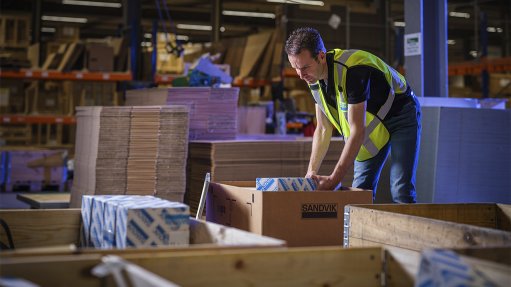
Sandvik is implementing sustainable packaging
Sandvik Mining and Rock Solutions aims to achieve at least 90% material circularity in its operations for products, waste and packaging and says it is already taking steps to reduce all unnecessary and single use packaging from the millions of spare parts leaving its main components warehouse each year.
Sandvik notes that each of its approximately 60 000 different components – ranging from tiny screws to giant 10-m-long tracks that weigh several tonnes – requires some form of sustainable packaging. The company estimates its current packaging costs at around €10-million yearly, saying that it makes business sense to ensure that packaging is minimised.
“We see driving a shift to more circular business models as a win-win,” said Sandvik Mining and Rock Solutions parts and services division global packaging specialist Corné Langenhuijsen. “Our 2030 Sustainability Goals take a holistic approach that includes not only our own operations but also our customers and suppliers. We’re not only reducing our own unnecessary and single use packaging but even that from the deliveries of our suppliers.”
“Data helps us drive improvement. Why buy packaging designed to hold twice the weight it will be used for? We started off using wooden crates, then switched to plywood, but now we favor corrugated cardboard boxes on wooden pallets. They’re cheaper, easy to recycle and easily strong enough.”
Sandvik highlights the importance of safety, ensuring that sustainable packaging protect its contents while also ensuring safe handling throughout the supply chain.
Streamlining logistics and planning helps to further reduce the carbon footprint of parts distribution, explains the company. For example, re-routing Chinese orders that arrive in The Netherlands to Sandvik’s Singapore facility for processing. Likewise, the Dutch facility initially sourced finished pallets from Finland, but importing the wood and making the pallets locally is cheaper, as well as more sustainable.
The use of sustainable materials such as responsibly sourced timber further reduces the impact on the environment. Plywood crates are sometimes used as preferred packaging, while even traditional plastics can sometimes be preferable to biodegradable alternatives, where suitable recycling and re-use facilities exist.
Langenhuijsen believes that tougher regulations may be required to encourage faster acceptance and adoption of sustainable packaging across the value chain. The recently introduced UK Plastic Packaging tax, which penalises production and use of materials with less than 30% recycled content, is an example of how legislation can play a role in supporting supplier sustainability.
“Like our components, we are on a journey,” Langenhuijsen said. “We can start by buying the most cost-effective packaging, but source it from companies that share our goals – perhaps producing boxes with green energy – and reusing as much packaging as possible. It’s an exciting mission to accelerate the transition to more sustainable packaging solutions.”